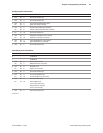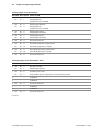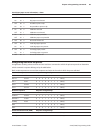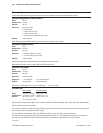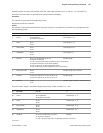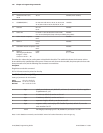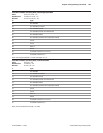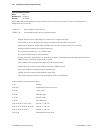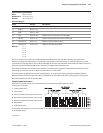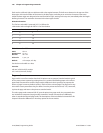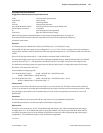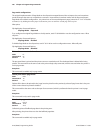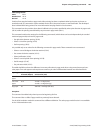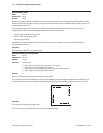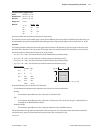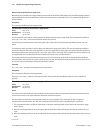
Chapter 5: Programming commands 105
A776-PG00001 C 12/09 A776 (B780) Programming Guide
Select PDF 417 parameters
ASCII GS p a b c d e f
Hexadecimal 1D 70 a b c d e f
Decimal 29 112 a b c d e f
Value and Ranges:
Value: Ranges: Description:
a, b = The ratio of bar height to symbol length.
a = height limit 1 to 10
b = width limit 1 to 100
c = rows limit 3 to 90 Number of rows in the matrix of code words.
d = columns limit 7 to 30 Number of columns in the matrix of code words.
e = x dimension limit 1 to 7 Width of a single module in dots.
f = y dimension limit 2 to 25 Height of the code word in dots.
Defaults: a = 1
b = 2
c = 58
d = 7
e = 3
f = 10
PDF 417 is a multi-row, continuous, variable length symbology which has high data capacity. Each symbol has
between 3 and 90 rows, with each row containing a start pattern, a left row indicator, 1 to 30 data characters, a right
row indicator and a stop pattern. The number and length of the rows are selectable, which allows the aspect ratio to be
adjusted to particular labeling applications. There are no separator bars between rows.
Each character has four bars and four spaces within 17 modules, and is assigned a value between 0 and 928. For this
symbology, it is common to refer to these character values as “code words.”
There are three mutually exclusive sets of symbol patterns, or clusters, each having 929 distinct patterns. Because
dierent clusters are used for adjacent rows, it is possible for the decoder to tell if the scanning path is crossing row
boundaries without the use of separator bars.
Sample symbol description:
Each PDF 417 symbol consists of 3 to 90 stacked rows surrounded on all four sides by a quiet
zone. Each row contains:
1 Leading quiet zone
2 Start pattern
3 Left row indicator characters (code words)
4 One to thirty data characters (code words)
5 Right row indicator character (code words)
6 Stop pattern
7 Trailing quiet zone
The number of characters in a row and number of rows can be adjusted to vary the symbol’s overall aspect ratio to best
t an available space.
Continued . . .



